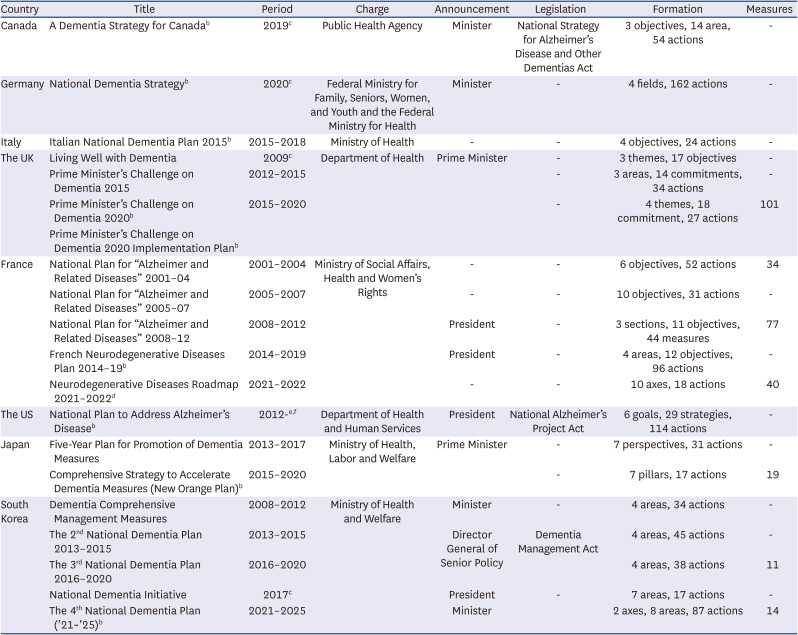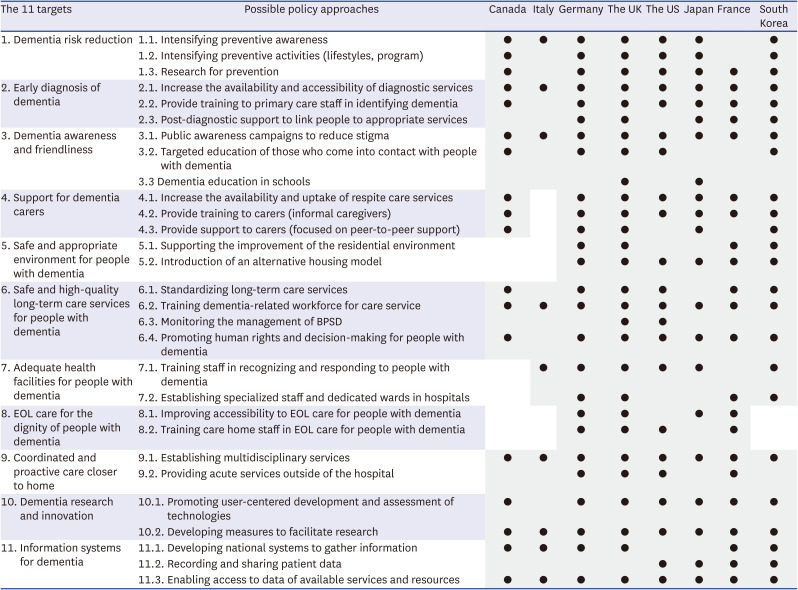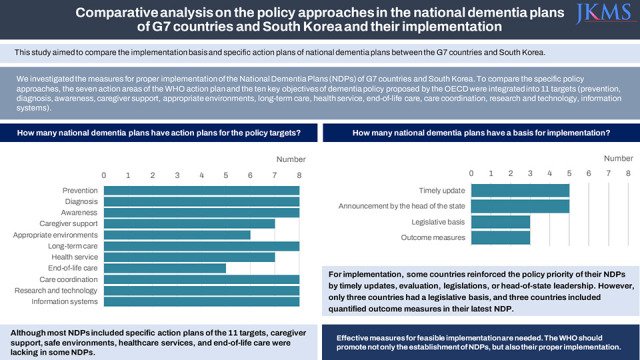2. GBD 2016 Dementia Collaborators. Global, regional, and national burden of Alzheimer’s disease and other dementias, 1990-2016: a systematic analysis for the Global Burden of Disease Study 2016. Lancet Neurol. 2019; 18(1):88–106. PMID:
30497964.
3. OECD Health Policy Studies. Addressing dementia: the OECD response. Updated 2015. Accessed March 15, 2021. DOI:
10.1787/9789264231726-en.
11. Seong SJ, Kim BN, Kim KW. National Dementia Plans of Group of Seven countries and South Korea based on international recommendations. JAMA Netw Open. 2022; 5(11):e2240027. PMID:
36326766.
12. Cahill S. WHO’s global action plan on the public health response to dementia: some challenges and opportunities. Aging Ment Health. 2020; 24(2):197–199. PMID:
30600688.
20. Alpérovitch A, Amouyel P, Dartigues JF, Ducimetière P, Mazoyer B, Ritchie K, et al. Epidemiological studies on aging in France: from the PAQUID study to the three-city study. C R Biol. 2002; 325(6):665–672. PMID:
12360853.
21. Han JW, Kim TH, Kwak KP, Kim K, Kim BJ, Kim SG, et al. Overview of the Korean longitudinal study on cognitive aging and dementia. Psychiatry Investig. 2018; 15(8):767–774.
24. Awata S. New national health program against dementia in Japan: the medical center for dementia. Psychogeriatrics. 2010; 10(2):102–106. PMID:
20738815.
25. Lee SB. The Community Dementia Reassurance Center (Chime Ansim Center) in South Korea. Ann Geriatr Med Res. 2019; 23(2):43–44. PMID:
32743286.
30. Le Duff F, Develay AE, Quetel J, Lafay P, Schück S, Pradier C, et al. 2008-2012 French Alzheimer plan: description of the national Alzheimer information system. J Alzheimers Dis. 2012; 29(4):891–902. PMID:
22366771.
33. Schmachtenberg T, Monsees J, Hoffmann W, van den Berg N, Stentzel U, Thyrian JR. Comparing national dementia plans and strategies in Europe - is there a focus of care for people with dementia from a migration background? BMC Public Health. 2020; 20(1):784. PMID:
32456616.
34. Nakanishi M, Nakashima T, Shindo Y, Miyamoto Y, Gove D, Radbruch L, et al. An evaluation of palliative care contents in national dementia strategies in reference to the European Association for Palliative Care white paper. Int Psychogeriatr. 2015; 27(9):1551–1561. PMID:
25678323.
35. Kim YJ, An H, Kim B, Park YS, Kim KW. An international comparative study on driving regulations on people with dementia. J Alzheimers Dis. 2017; 56(3):1007–1014. PMID:
28059784.
36. Teper MH, Godard-Sebillotte C, Vedel I. Achieving the goals of dementia plans: a review of evidence-informed implementation strategies. World Health Popul. 2019; 18(1):37–46. PMID:
31917668.
37. Lin SY, Lewis FM. Dementia friendly, dementia capable, and dementia positive: concepts to prepare for the future. Gerontologist. 2015; 55(2):237–244. PMID:
26035599.
38. Nakanishi M, Nakashima T. Features of the Japanese national dementia strategy in comparison with international dementia policies: How should a national dementia policy interact with the public health- and social-care systems? Alzheimers Dement. 2014; 10(4):468–476.e3. PMID:
23954026.
39. Fortinsky RH, Downs M. Optimizing person-centered transitions in the dementia journey: a comparison of national dementia strategies. Health Aff (Millwood). 2014; 33(4):566–573. PMID:
24711316.
43. Sun F, Chima E, Wharton T, Iyengar V. National policy actions on dementia in the Americas and Asia-Pacific: consensus and challenges. Rev Panam Salud Publica. 2020; 44(e2):
46. Chow S, Chow R, Wan A, Lam HR, Taylor K, Bonin K, et al. National dementia strategies: what should Canada learn? Can Geriatr J. 2018; 21(2):173–209. PMID:
29977433.
47. Wright T, O’Connor S. Reviewing challenges and gaps in European and global dementia policy. J Public Ment Health. 2018; 17(4):157–167. PMID:
30581491.
48. Smith AE, Kamm GL, Lai S, Hull MJ, Baker JR, Milte R, et al. A RE-AIM analysis of an Intergenerational Dementia Education Program. Front Public Health. 2020; 8:248. PMID:
32719762.
49. Rosow K, Holzapfel A, Karlawish JH, Baumgart M, Bain LJ, Khachaturian AS. Countrywide strategic plans on Alzheimer’s disease: developing the framework for the international battle against Alzheimer’s disease. Alzheimers Dement. 2011; 7(6):615–621. PMID:
22055978.
50. Engedal K, Laks J. Towards a Brazilian dementia plan? Lessons to be learned from Europe. Dement Neuropsychol. 2016; 10(2):74–78. PMID:
29213437.
51. Wortmann M. Importance of national plans for Alzheimer’s disease and dementia. Alzheimers Res Ther. 2013; 5(5):40. PMID:
24007939.
52. Edick C, Holland N, Ashbourne J, Elliott J, Stolee P. A review of Canadian and international dementia strategies. Healthc Manage Forum. 2017; 30(1):32–39. PMID:
28929900.
53. Barnes DE, Yaffe K. The projected effect of risk factor reduction on Alzheimer’s disease prevalence. Lancet Neurol. 2011; 10(9):819–828. PMID:
21775213.
54. Satizabal CL, Beiser AS, Chouraki V, Chêne G, Dufouil C, Seshadri S. Incidence of dementia over three decades in the Framingham heart study. N Engl J Med. 2016; 374(6):523–532. PMID:
26863354.
55. Farina MP, Zhang YS, Kim JK, Hayward MD, Crimmins EM. Trends in dementia prevalence, incidence, and mortality in the United States (2000–2016). J Aging Health. 2022; 34(1):100–108. PMID:
34233528.
56. Ding M, Qiu C, Rizzuto D, Grande G, Fratiglioni L. Tracing temporal trends in dementia incidence over 25 years in central Stockholm, Sweden. Alzheimers Dement. 2020; 16(5):770–778. PMID:
32270625.
57. Park JE, Kim BS, Kim KW, Hahm BJ, Sohn JH, Suk HW, et al. Decline in the incidence of all-cause and Alzheimer’s disease dementia: a 12-year-later rural Cohort study in Korea. J Korean Med Sci. 2019; 34(44):e293. PMID:
31726496.
58. Cho SJ, Kang JM. Dementia incidence on the decline in Korea: lessons learned and future directions. J Korean Med Sci. 2019; 34(44):e299. PMID:
31726497.
59. Kim YJ, Han JW, So YS, Seo JY, Kim KY, Kim KW. Prevalence and trends of dementia in Korea: a systematic review and meta-analysis. J Korean Med Sci. 2014; 29(7):903–912. PMID:
25045221.
60. Lee Y. The recent decline in prevalence of dementia in developed countries: implications for prevention in the Republic of Korea. J Korean Med Sci. 2014; 29(7):913–918. PMID:
25045222.






 PDF
PDF Citation
Citation Print
Print




 XML Download
XML Download